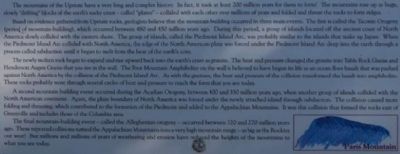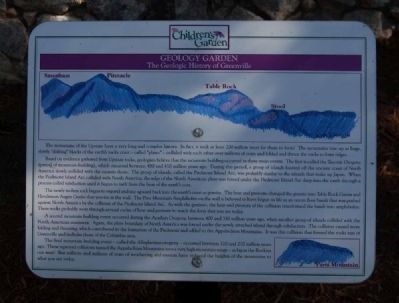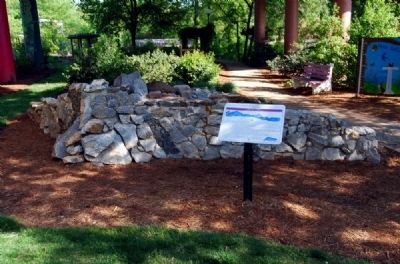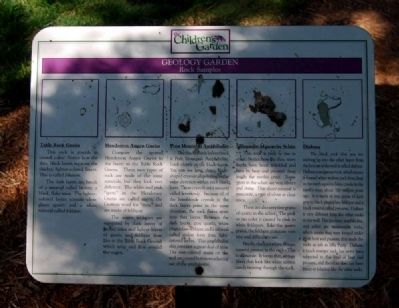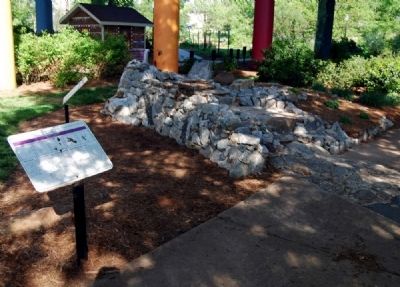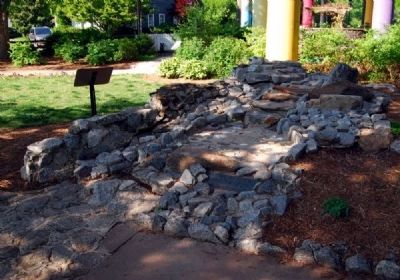Greenville in Greenville County, South Carolina — The American South (South Atlantic)
The Geologic History of Greenville
The Children's Garden
— Geology Garden —
The mountains of the Upstate have a very long and complex history. In fact, it took at least 200 million years for them to form! The mountains rose up as huge slowly "drifting" blocks of the earth's rocky crust -- called "plates" -- collided with each other over millions of years and folded and thrust the rocks to form ridges.
Based on evidence gathered from Upstate rocks, geologists believe that the mountain building occurred in three main events. The first is called the Taconic Orogeny (period of mountain-building), which occurred between 480 and 450 million years ago. During this period, a group of islands located off the ancient coast of North America slowly collided with the eastern shore. The group of islands, called the Piedmont Island Arc, was probably similar to the islands that make up Japan. When the Piedmont Island Arc collided with North America, the edge of the North American plate was forced under the Piedmont Island Arc deep into the earth through a process called subduction until it began to melt from the heat of the earth's core.
The newly molten rock began to expand and rise upward back into the earth's crust as granite. The eat and pressure changed the granite unto Table Rock Gneiss and Henderson Augen Gneiss that you see in the wall. The Poor Mountain Amphibolite on the wall is believed to have begun its life as an ocean floor basalt that was pushed against North America by the collision on the Piedmont Island Arc. As with the genisses, the heat and pressure of the collision transformed the basalt into amphibolite. These rocks probably went through several cycles of heat and pressure to reach the form that you see today.
The second mountain building event occurred during the Acadian Orogeny between 400 and 350 million years ago, when another group of islands collided with the North American continent. again, the plate boundary of North America was forced under the newly attached island through subduction. The collision caused more folding and thrusting, which contributed to the formation of the Piedmont and added to the Appalachian Mountains. It was this collision that formed the rocks east of Greenville and includes those of the Columbia area.
The final mountain-building event -- called the Alleghenian Orogeny -- occurred between 320 and 270 million years ago. These repeated collisions turned the Appalachian Mountains into a very high mountain range -- as big as the Rockies out west! But millions and millions of years of weathering and erosion have reduced the heights of the mountains to what you see today.
Rock Samples
Table Rock Gneiss
This rock is grayish in overall color. Notice how the thin black layers separate the thicker, lighter-colored layers. This is called foliation.
The dark layers are bands of a mineral called biotite; a black, flaky mica. The lighter-colored layers contain clear, glassy quartz and a white mineral called feldspar.
Henderson Augen Gneiss
Compare the spotted Henderson Augen Gneiss to the layers in the table Rock Gneiss. These two types of rock are made of the same minerals, but they look very different. The white and pink "spots" in the Henderson Gneiss are called augen, the German word for "eyes," and are made of feldspar.
The augen feldspar are separated by dark layers of biotite mica and lighter layers of quartz and feldspar (just like in the Table Rock Gneiss) which wrap and flow around the augen.
Poor Mountain Amphibolite
The black, thinly layered rock is Poor Mountain Amphibolite. Look closely at the black layers. You can see long, shiny, blade-shaped crystals all pointing in the same direction within each black layer. These crystals are a mineral called hornblende. Because all of the hornblende crystals in the dark layers point in the same direction, the rock flakes apart into thin layers. between the dark layers, gray quartz, white plagioclase feldspar, and a mineral called epidote form thin, light colored layers. This amphibolite also contains a great deal of iron. The rust colored stains on the wall are caused by iron weathering out of the amphibolite.
Sillimanite-Muscovite Schist
This rock is pink to tan in color. Notice how the thin, wavy layers have been wrinkled and bent by heat and pressure deep inside the earth's crust. Some spots in the schist are very silvery and shiny. This shiny mineral is muscovite, a type of silver or clear mica.
There are also very tiny grains of quarts in the schist. The pink or tan color is caused by pink to white feldspars. Like the quarts grains, the feldspar grains are very tiny and difficult to see.
Finally, there is a white, fibrous mineral present in the rock. This is sillimanite. It forms thin, stringy fibers that look like white cotton candy twisted through the rock.
Diabase
The black rock that you see sticking up into the other layers from the bottom of the wall is called diabase. Diabase is an igneous rock, which means it formed when molten rock from deep in the earth squeezed into cracks in the earth's crust about 180 million years ago. It is made of tiny grains of dark gray yo black plagioclase feldspar and a black mineral called pyrozene. Diabase is very different from the other rocks in the wall. The gneisses, amphibolite, and schist are metamorphic rocks, which means they were formed under great heat and pressure that made the rocks as soft as Silly Putty. Diabase, a much younger rock, has never been subjected to this kind of heat and pressure, and therefore does not have layers of foliation like the other rocks.
Erected by City of Greenville Parks and Recreation.
Topics. This historical marker is listed in these topic lists: Landmarks • Natural Features.
Location. 34° 50.933′ N, 82° 24.217′ W. Marker is in Greenville, South Carolina, in Greenville County. Marker can be reached from Reedy View Drive. Marker is located on the grounds of the Children's Garden at Linky Stone Park. Touch for map. Marker is at or near this postal address: 24 Reedy View Drive, Greenville SC 29601, United States of America. Touch for directions.
Other nearby markers. At least 10 other markers are within walking distance of this marker. Historic Plants Garden (within shouting distance of this marker); Historic River Cane (within shouting distance of this marker); History of the Reedy River (within shouting distance of this marker); Linky Stone Park (within shouting distance of this marker); Huguenot Mill Office (about 500 feet away, measured in a direct line); Carolina Supply Company (about 800 feet away); Downtown Baptist Church (approx. 0.2 miles away); Greenville County Courthouse / The Willie Earle Lynching Trial (approx. 0.2 miles away); Buck Mickel (approx. 0.2 miles away); Josh White (approx. 0.2 miles away). Touch for a list and map of all markers in Greenville.
Also see . . .
1. Taconic Orogeny. The Taconic orogeny was a great mountain building period that perhaps had the greatest overall effect on the geologic structure of basement rocks within the New York Bight region. (Submitted on May 27, 2010, by Brian Scott of Anderson, South Carolina.)
2. Acadian Orogeny. The Acadian orogeny is a middle Paleozoic mountain building event (orogeny), especially in the northern Appalachians, between New York and Newfoundland. (Submitted on May 27, 2010, by Brian Scott of Anderson, South Carolina.)
3. Alleghenian Orogeny. The Alleghenian orogeny or Appalachian orogeny is one of the geological mountain-forming events (orogeny) that formed the Appalachian Mountains and Allegheny Mountains. (Submitted on May 27, 2010, by Brian Scott of Anderson, South Carolina.)
Credits. This page was last revised on November 17, 2020. It was originally submitted on May 27, 2010, by Brian Scott of Anderson, South Carolina. This page has been viewed 1,971 times since then and 156 times this year. Photos: 1, 2, 3, 4, 5, 6. submitted on May 27, 2010, by Brian Scott of Anderson, South Carolina.
